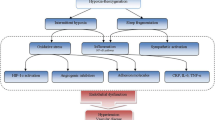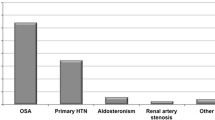Abstract
Obstructive sleep apnea syndrome (OSAS) is an independent risk factor for atherosclerosis and arterial thrombosis, which are associated with high cardiovascular (CV) morbidity and mortality. In studies performed in clinical populations with elevated CV event risk profiles, the occurrence of moderate to severe OSAS was very often accompanied by a worsened vascular function and increased prevalence of structural abnormalities. Recent investigations of atherosclerosis in OSAS have focused on thrombotic tendency and blood viscosity, providing new insight into mechanisms of the disease. Despite that knowledge about the mechanisms of development of CV disease in patients with OSAS is still incomplete, observations confirm a relationship between sleep-disordered breathing and the rheological properties (flow properties) of blood. While platelet dysfunction and hypercoagulability (PDMPs, PaI-1, and SF) play important roles in the pathogenesis of vascular disease, there are limited studies on the potential role of blood viscosity in the development of vascular disease in OSAS.
Similar content being viewed by others
References
Young T, Palta M, Dempsey J, Skatrud J, Weber S, Badr S (1993) The occurrence of sleep-disordered breathing among middle-aged adults. N Engl J Med 328:1230–1235
Marin JM, Carrizo SJ, Vicente E, Agusti AG (2005) Long-term cardiovascular outcomes in men with obstructive sleep apnoea–hypopnoea with or without treatment with continuous positive airway pressure: an observational study. Lancet 365:1046–1053
Somers VK, White DP, Amin R, Abraham WT, Costa F, Culebras A et al (2008) Sleep apnea and cardiovascular disease: an American Heart Association/American College of Cardiology Foundation Scientific Statement from the American Heart Association Council for High Blood Pressure Research Professional Education Committee, Council on Clinical Cardiology, Stroke Council, and Council On Cardiovascular Nursing. In collaboration with the National Heart, Lung, and Blood Institute National Center on Sleep Disorders Research (National Institutes of Health). Circulation 118:1080–1111
Minoguchi K, Yokoe T, Tazaki T, Minoguchi H, Tanaka A, Oda N, Okada S, Ohta S, Naito H, Adachi M (2005) Increased carotid intima-media thickness and serum inflammatory markers in obstructive sleep apnea. Am J Respir Crit Care Med 172:625–630
Ip MS, Tse HF, Lam B, Tsang KW, Lam WK (2004) Endothelial function in obstructive sleep apnea and response to treatment. Am J Respir Crit Care Med 169:348–353
Buchner NJ, Sanner BM, Borgel J, Rump LC (2007) Continuous positive airway pressure treatment of mild to moderate obstructive sleep apnea reduces cardiovascular risk. Am J Respir Crit Care Med 176:1274–1280
Sorajja D, Gami AS, Somers VK, Behrenbeck TR, Garcia-Touchard A, Lopez-Jimenez F (2008) Independent association between obstructive sleep apnea and subclinical coronary artery disease. Chest 133:927–929
Baskurt OK, Hardeman MR, Rampling MW, Meiselman HJ (2007) Handbook of Hemorheology and Hemodynamics. IOS, Lansdale
Holsworth RE, Wright JV (2012) Blood viscosity: the unifying parameter in cardiovascular disease risk. Holist Prim Ore 13:1
Rafnsson S, Deary IJ, Whiteman MC, Rumley A, Lowe GD, Fowkes FG (2010) Haemorheological predictors of cognitive decline: the Edinburgh Artery Study. Age Ageing 39:217–222
Ciuffetti G, Schillaci G, Lombardini R, Pirro M, Vaudo G, Mannarino E (2005) Prognostic impact of low-shear whole blood viscosity in hypertensive men. Eur J Clin Invest 35:93–98
Housley E, Cawood EH, Macintyre CC, Ruckley CV, Prescott RJ (1991) Edinburgh Artery Study: prevalence of asymptomatic and symptomatic peripheral arterial disease in the general population. Int J Epidemiol 20:384–392
Lowe GDO, Wood DA, Douglas JT, Riemersma RA, Mcintyre CCA, Takase T, Tuddenham EGD, Forbes CD, Elton RA, Oliver MF (1991) Relationships of plasma viscosity, coagulation and fibrinolysis to coronary risk factors and angina. Thromb Haemost 65:339–343
Meade TW, North WR, Chakrabarti R, Stirling Y, Haines AP, Thompson SG, Brozovié M (1980) Haemostatic function and cardiovascular death: early results of a prospective study. Lancet 1:1050–1054
Lee AJ, Smith WC, Lowe GD, Tunstall-Pedoe H (1990) Plasma fibrinogen and coronary risk factors: The Scottish Heart Health Study. J Clin Epidemiol 43:913–919
Dikmenoğlu N, Ciftçi B, Ileri E, Güven SF, Seringeç N, Aksoy Y, Ercil D (2006) Erythrocyte deformability, plasma viscosity and oxidative status in patients with severe obstructive sleep apnea syndrome. Sleep Med 7:255–261
Landgraf H (1999) Correlation between plasma viscosity and tissue oxygen tension. Clin Hemorheol Microcirc 20:37–40
Parish JM, Somers VK (2004) Obstructive sleep apnea and cardiovascular disease. Mayo Clin Proc 79:1036–1046
Steiner S, Jax T, Evers S, Hennersdorf M, Schwalen A, Strauer BE (2005) Altered blood rheology in obstructive sleep apnea as a mediator of cardiovascular risk. Cardiology 104:92–96
Tazbirek M, Slowińska L, Skoczyński S, Pierzchała W (2009) Short-term continuous positive airway pressure therapy reverses the pathological influence of obstructive sleep apnea on blood rheology parameters. Clin Hemorheol Microcirc 41:241–249
Chin K, Ohi M, Kita H, Noguchi T, Otsuka N, Tsuboi T, Mishima M, Kuno K (1996) Effects of NCPAP therapy on fibrinogen levels in obstructive sleep apnea syndrome. Am J Respir Crit Care Med 153:1972–1976
Nobili L, Schiavi G, Bozano E, De Carli F, Ferrillo F, Nobili F (2000) Morning increase of whole blood viscosity in obstructive sleep apnea syndrome. Clin Hemorheol Microcirc 22:21–27
Reinhart WH, Oswald J, Walter R, Kuhn M (2002) Blood viscosity and platelet function in patients with obstructive sleep apnea syndrome treated with nasal continuous positive airway pressure. Clin Hemorheol Microcirc 27:201–207
Zhang X, Yin K, Wang H, Su M, Yang Y (2003) Effect of continuous positive airway pressure treatment on elderly Chinese patients with obstructive sleep apnea in the prothrombotic state. Chin Med J (Engl) 116:1426–1428
Lowe GD (1992) Blood viscosity, lipoproteins and cardiovascular risk. Circulation 85:2329–2331
De Simone G, Devereux RB, Chien S, Alderman MH, Atlas SA, Larach JH (1990) Relation of blood viscosity to demographic and physiologic variables and to cardiovascular risk factors in apparently normal adults. Circulation 81:107–117
Fanari P, Somazzi R, Nasrawi F, Ticozzelli P, Grugni G, Agosti R, Longhini E (1993) Haemorheological changes in obese adolescents after short-term diet. Int J Obes Relat Metab Disord 17:487–494
Heinrich J, Balleisen L, Schulte H, Assmann G, van de Loo J (1994) Fibrinogen and factor VII in the prediction of coronary risk. Results from the PROCAM study in healthy men. Arterioscler Thromb 14:54–59
Wessendorf TE, Thilmann AF, Wang YM, Schreiber A, Konietzko N, Teschler H (2000) Fibrinogen levels and obstructive sleep apnea in ischemic stroke. Am J Respir Crit Care Med 162:2039–2042
McNicholas WT, Bonsignore, The Management Committee of EU COST ACTION B26 (2007) Sleep apnoea as an independent risk factor for cardiovascular disease: current evidence, basic mechanism and research priorities. Eur Respir J 29:156–178
Lavie L (2003) Obstructive sleep apnoea syndrome—an oxidative stress disorder. Sleep Med Rev 7:35–51
Nieto FJ, Herrington DM, Redline S, Benjamin EJ, Robbins JA (2004) Sleep apnea and markers of vascular endothelial function in a large community sample of older adults. Am J Respir Crit Care Med 169:354–360
von Känel R, Dimsdale JE (2003) Hemostatic alterations in patients with obstructive sleep apnea and the implications for cardiovascular disease. Chest 124:1956–1967
Mackman N (2009) On the trail of microparticles. Circ Res 104:925–927
Nomura S (2001) Function and clinical significance of platelet-derived microparticles. Int J Hematol 74:397–404
Sinauridze EI, Kireev DA, Popenko NY, Pichugin AV, Panteleev MA, Krymskaya OV, Ataullakhanov FI (2007) Platelet microparticle membranes have 50- to 100-fold higher specific procoagulant activity than activated platelets. Thromb Haemost 97(3):425–434
Gilbert GE, Sims PJ, Wiedmer T, Furie B, Furie BC, Shattil SJ (1991) Platelet-derived microparticles express high affinity receptors for factor VIII. J Biol Chem 266:17261–17268
Dougu N, Takashima S, Sasahara E, Taguchi Y, Toyoda S, Hirai T, Nozawa T, Tanaka K, Inoue H (2011) Predictors of poor outcome in patients with acute cerebral infarction. J Clin Neurol 7(4):197–202
Shitrit D, Peled N, Shitrit AB, Meidan S, Bendayan D, Sahar G, Kramer MR (2005) An association between oxygen desaturation and D-dimer in patients with obstructive sleep apnea syndrome. Thromb Haemost 94:544–547
von Kanel R, Loredo JS, Powell FL, Adler KA, Dimsdale JE (2005) Short-term isocapnic hypoxia and coagulation activation in patients with sleep apnea. Clin Hemorheol Microcirc 33:369–377
Kaditis AG, Alexopoulos EI, Kalampouka E, Kostadima E, Angelopoulos N, Germenis A, Zintzaras E, Gourgoulianis K (2004) Morning levels of fibrinogen in children with sleep disordered breathing. Eur Respir J 24:790–797
Shimizu M, Kamio K, Haida M, Ono Y, Miyachi H, Yamamoto M, Shinohara Y, Ando Y (2002) Platelet activation in patients with obstructive sleep apnea syndrome and effects of nasal-continuous positive airway pressure. Tokai J Exp Clin Med 27:107–112
Hui DS, Ko FW, Fok JP, Chan MC, Li TS, Tomlinson B, Cheng G (2004) The effects of nasal continuous positive airway pressure on platelet activation in obstructive sleep apnea syndrome. Chest 125:1768–1775
Geiser T, Buck F, Meyer BJ, Bassetti C, Haeberli A, Gugger M (2002) In vivo platelet activation is increased during sleep in patients with obstructive sleep apnea syndrome. Respiration 69:229–234
Siegal T, Seligsohn U, Aghai E, Modan M (1978) Clinical and laboratory aspects of disseminated intravascular coagulation (DIC): a study of 118 cases. Thromb Haemost 39:122–134
Plaikner M, Peer A, Falkensammer G, Schmidauer C, Pechlaner C, Griesmacher A, Pachinger O, Mair J (2009) Lack of association of soluble CD40 ligand with the presence of acute myocardial infarction or ischemic stroke in the emergency department. Clin Chem 55(1):175–178
Jacobin-Valat MJ, Deramchia K, Mornet S, Hagemeyer CE, Bonetto S, Robert R, Biran M, Massot P, Miraux S, Sanchez S, Bouzier-Sore AK, Franconi JM, Duguet E, Clofent-Sanchez G (2010) MRI of inducible P-selectin expression in human activated platelets involved in the early stages of atherosclerosis. NMR Biomed 24:413–424
Robinson GV, Pepperell JC, Segal HC, Davies RJ, Stradling JR (2004) Circulating cardiovascular risk factors in obstructive sleep apnea: data from randomised controlled trial. Thorax 59:777–782
Ryan S, Taylor CT, McNicholas WT (2009) Systemic inflammation: a key factor in the pathogenesis of cardiovascular complications in obstructive sleep apnea syndrome? Thorax 64:631–636
Maruyama K, Morishita E, Sekiya A, Omote M, Kadono T, Asakura H, Hashimoto M, Kobayashi M, Nakatsumi Y, Takada S, Ohtake S (2012) Plasma levels of platelet-derived microparticles in patients with obstructive sleep apnea. J Atheroscler Thromb 19(1):98–104
Arnulf I, Merino-Andreu M, Perrier A, Birolleau S, Similowski T, Derenne JP (2002) Obstructive sleep apnea and venous thromboembolism. JAMA 287:2655–2656
Ambrosetti M, Lucioni A, Ageno W, Conti S, Neri M (2004) Is venous thromboembolism more frequent in patients with obstructive sleep apnea syndrome? J Thromb Haemost 2:1858–1860
Epstein MD, Segal LN, Ibrahim SM, Friedman N, Bustami R (2010) Snoring and the risk of obstructive sleep apnea in patients with pulmonary embolism. Sleep 33:1069–1074
Haus E (1996) Biologic rhythms in hematology. Patol Biol (Paris) 44:618–630
Lamont EW, James FO, Boivin DB, Cermakian N (2007) From circadian clock gene expression to pathologies. Sleep Med 8:547–556
Barceló A, Piérola J, de la Peña M, Esquinas C, Sanchez-de la Torre M, Ayllón O, Alonso A, Agusti AG, Barbè F (2011) Day-night variations in endothelial dysfunction markers and haemostatic factors in sleep apnoea. Eur Respir J 39:913–918
Acknowledgments
The authors thank Miss Stephanie Grice MBiochem, MSc (Oxon), from the UK, for the editing of this manuscript.
Conflict of interest
The authors have no conflicts of interest or financial ties to disclose.
Author information
Authors and Affiliations
Corresponding author
Rights and permissions
About this article
Cite this article
Toraldo, D.M., Peverini, F., De Benedetto, M. et al. Obstructive Sleep Apnea Syndrome: Blood Viscosity, Blood Coagulation Abnormalities, and Early Atherosclerosis. Lung 191, 1–7 (2013). https://doi.org/10.1007/s00408-012-9427-3
Received:
Accepted:
Published:
Issue Date:
DOI: https://doi.org/10.1007/s00408-012-9427-3




